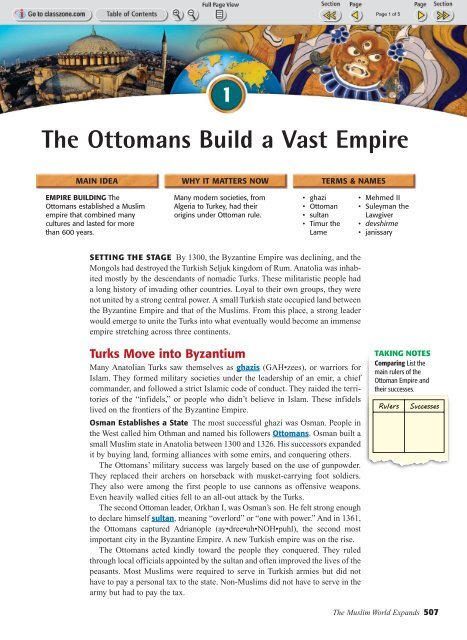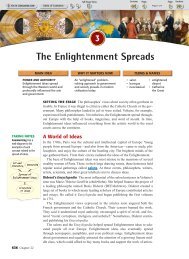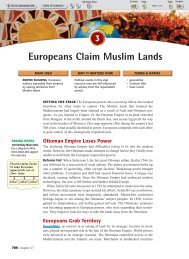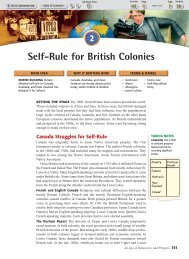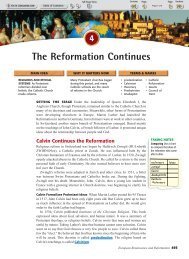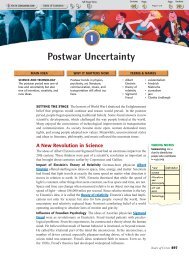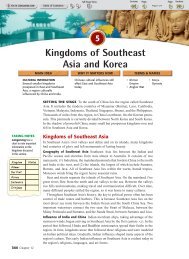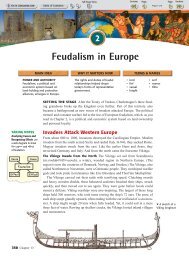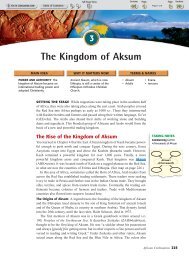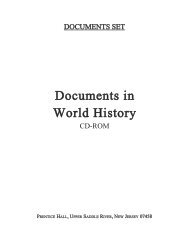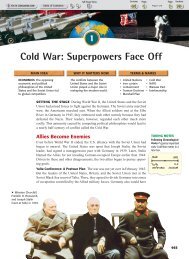The Ottomans Build a Vast Empire - Typepad
The Ottomans Build a Vast Empire - Typepad
The Ottomans Build a Vast Empire - Typepad
You also want an ePaper? Increase the reach of your titles
YUMPU automatically turns print PDFs into web optimized ePapers that Google loves.
1<strong>The</strong> <strong>Ottomans</strong> <strong>Build</strong> a <strong>Vast</strong> <strong>Empire</strong>MAIN IDEA WHY IT MATTERS NOW TERMS & NAMESEMPIRE BUILDING <strong>The</strong><strong>Ottomans</strong> established a Muslimempire that combined manycultures and lasted for morethan 600 years.Many modern societies, fromAlgeria to Turkey, had theirorigins under Ottoman rule.• ghazi• Ottoman• sultan• Timur theLame• Mehmed II• Suleyman theLawgiver• devshirme• janissarySETTING THE STAGE By 1300, the Byzantine <strong>Empire</strong> was declining, and theMongols had destroyed the Turkish Seljuk kingdom of Rum. Anatolia was inhabitedmostly by the descendants of nomadic Turks. <strong>The</strong>se militaristic people hada long history of invading other countries. Loyal to their own groups, they werenot united by a strong central power. A small Turkish state occupied land betweenthe Byzantine <strong>Empire</strong> and that of the Muslims. From this place, a strong leaderwould emerge to unite the Turks into what eventually would become an immenseempire stretching across three continents.Turks Move into ByzantiumMany Anatolian Turks saw themselves as ghazis (GAH•zees), or warriors forIslam. <strong>The</strong>y formed military societies under the leadership of an emir, a chiefcommander, and followed a strict Islamic code of conduct. <strong>The</strong>y raided the territoriesof the “infidels,” or people who didn’t believe in Islam. <strong>The</strong>se infidelslived on the frontiers of the Byzantine <strong>Empire</strong>.Osman Establishes a State <strong>The</strong> most successful ghazi was Osman. People inthe West called him Othman and named his followers <strong>Ottomans</strong>. Osman built asmall Muslim state in Anatolia between 1300 and 1326. His successors expandedit by buying land, forming alliances with some emirs, and conquering others.<strong>The</strong> <strong>Ottomans</strong>’ military success was largely based on the use of gunpowder.<strong>The</strong>y replaced their archers on horseback with musket-carrying foot soldiers.<strong>The</strong>y also were among the first people to use cannons as offensive weapons.Even heavily walled cities fell to an all-out attack by the Turks.<strong>The</strong> second Ottoman leader, Orkhan I, was Osman’s son. He felt strong enoughto declare himself sultan, meaning “overlord” or “one with power.” And in 1361,the <strong>Ottomans</strong> captured Adrianople (ay•dree•uh•NOH•puhl), the second mostimportant city in the Byzantine <strong>Empire</strong>. A new Turkish empire was on the rise.<strong>The</strong> <strong>Ottomans</strong> acted kindly toward the people they conquered. <strong>The</strong>y ruledthrough local officials appointed by the sultan and often improved the lives of thepeasants. Most Muslims were required to serve in Turkish armies but did nothave to pay a personal tax to the state. Non-Muslims did not have to serve in thearmy but had to pay the tax.TAKING NOTESComparing List themain rulers of theOttoman <strong>Empire</strong> andtheir successes.RulersSuccesses<strong>The</strong> Muslim World Expands 507
Timur the Lame Halts Expansion <strong>The</strong> rise of the Ottoman <strong>Empire</strong> was brieflyinterrupted in the early 1400s by a rebellious warrior and conqueror from Samarkandin Central Asia. Permanently injured by an arrow in the leg, he was calledTimur-i-Lang, or Timur the Lame. Europeans called him Tamerlane. Timurburned the powerful city of Baghdad in present-day Iraq to the ground. He crushedthe Ottoman forces at the Battle of Ankara in 1402. This defeat halted the expansionof their empire.Powerful Sultans Spur Dramatic ExpansionSoon Timur turned his attention to China. When he did, war broke out among thefour sons of the Ottoman sultan. Mehmed I defeated his brothers and took thethrone. His son, Murad II, defeated the Venetians, invaded Hungary, and overcamean army of Italian crusaders in the Balkans. He was the first of four powerful sultanswho led the expansion of the Ottoman <strong>Empire</strong> through 1566.Mehmed II Conquers Constantinople Murad’s son Mehmed II, or Mehmed theConqueror, achieved the most dramatic feat in Ottoman history. By the timeMehmed took power in 1451, the ancient city of Constantinople had shrunk froma population of a million to a mere 50,000. Although it controlled no territory outsideits walls, it still dominated the Bosporus Strait. Controlling this waterwaymeant that it could choke off traffic between the <strong>Ottomans</strong>’ territories in Asia andin the Balkans.Mehmed II decided to face this situation head-on. “Give me Constantinople!” hethundered, shortly after taking power at age 21. <strong>The</strong>n, in 1453, he launched his attack.Ottoman <strong>Empire</strong>, 1451–1566ViennaAUSTRIA40° EOttoman <strong>Empire</strong>, 1451Acquisitions to 1481Acquisitions to 1521Acquisitions to 1566Dniester R.0°HUNGARYFRANCEDanube R.BelgradeCRIMEAMadridSPAINAlgiersALGERIAAFRICA0 500 MilesTunisTUNISIA0 1,000 KilometersITALYRomeNaplesPalermoTripoliAdriatic SeaM e d i te rTRIPOLITarantoS A H A R Ar a nBALKANSAdrianopleGREECEAthensCretee a n S e aGEOGRAPHY SKILLBUILDER: Interpreting Maps1. Location To which waterways did the Ottoman <strong>Empire</strong> have access?2. Movement In which time period did the Ottoman <strong>Empire</strong> gain the most land?508 Chapter 18BosporusEGYPTNileBlack SeaConstantinople(Istanbul)CairoCyprusPALESTINEJerusalemR.Red SeaEuphrates R.SYRIADamascusARABIAMedinaC AU C A S U S M T S .TigrisR.BaghdadMESOPOTAMIAC a s p i a n S e a40° NTehranPERSIAPersian Gulf
Suleyman the Lawgiver1494–1566In the halls of the U.S. Congress areimages of some of the greatestlawgivers of all time. Included in thatgroup are such persons as ThomasJefferson, Moses, and Suleyman.Suleyman’s law code prescribedpenalties for various criminal actsand for bureaucratic and financialcorruption. He also sought to reducebribes, did not allow imprisonmentwithout a trial, and rejected promotionsthat were not based on merit.He also introduced the idea of abalanced budget for governments.RESEARCH LINKS For more onSuleyman, go to classzone.comSuleyman the Lawgiver<strong>The</strong> Ottoman <strong>Empire</strong> didn’t reach its peak size andgrandeur until the reign of Selim’s son, Suleyman I(SOO•lay•mahn). Suleyman came to the throne in 1520 andruled for 46 years. His own people called him Suleymanthe Lawgiver. He was known in the West, though, asSuleyman the Magnificent. This title was a tribute to thesplendor of his court and to his cultural achievements.<strong>The</strong> <strong>Empire</strong> Reaches Its Limits Suleyman was a superbmilitary leader. He conquered the important European cityof Belgrade in 1521. <strong>The</strong> next year, Turkish forces capturedthe island of Rhodes in the Mediterranean and now dominatedthe whole eastern Mediterranean.Applying their immense naval power, the <strong>Ottomans</strong> capturedTripoli on the coast of North Africa. <strong>The</strong>y continuedconquering peoples along the North African coastline.Although the <strong>Ottomans</strong> occupied only the coastal cities ofNorth Africa, they managed to control trade routes to the interiorof the continent.In 1526, Suleyman advanced into Hungary and Austria,throwing central Europe into a panic. Suleyman’s armiesthen pushed to the outskirts of Vienna, Austria. Reigningfrom Istanbul, Suleyman had waged war with centralEuropeans, North Africans, and Central Asians. He hadbecome the most powerful monarch on earth. Only CharlesV, head of the Hapsburg <strong>Empire</strong> in Europe, came close torivaling his power.Highly Structured Social Organization Binding theOttoman <strong>Empire</strong> together in a workable social structure wasSuleyman’s crowning achievement. <strong>The</strong> massive empirerequired an efficient government structure and social organization.Suleyman created a law code to handle both criminaland civil actions. He also simplified the system oftaxation and reduced government bureaucracy. <strong>The</strong>se changes bettered the dailylife of almost every citizen and helped earn Suleyman the title of Lawgiver.<strong>The</strong> sultan’s 20,000 personal slaves staffed the palace bureaucracy. <strong>The</strong> slaveswere acquired as part of a policy called devshirme (dehv•SHEER•meh). Under thedevshirme system, the sultan’s army drafted boys from the peoples of conqueredChristian territories. <strong>The</strong> army educated them, converted them to Islam, and trainedthem as soldiers. An elite force of 30,000 soldiers known as janissaries wastrained to be loyal to the sultan only. <strong>The</strong>ir superb discipline made them the heartof the Ottoman war machine. In fact, Christian families sometimes bribed officialsto take their children into the sultan’s service, because the brightest ones could riseto high government posts or military positions.As a Muslim, Suleyman was required to follow Islamic law. In accordance withIslamic law, the <strong>Ottomans</strong> granted freedom of worship to other religious communities,particularly to Christians and Jews. <strong>The</strong>y treated these communities as millets, ornations. <strong>The</strong>y allowed each millet to follow its own religious laws and practices. <strong>The</strong>head of the millets reported to the sultan and his staff. This system kept conflict amongpeople of the various religions to a minimum.MakingInferencesWhat were theadvantages of thedevshirme systemto the sultan?510 Chapter 18
ComparingWhich culturalachievements ofSuleyman’s reignwere similar tothe EuropeanRenaissance?Cultural Flowering Suleyman hadbroad interests, which contributed tothe cultural achievements of theempire. He found time to study poetry,history, geography, astronomy, mathematics,and architecture. He employedone of the world’s finest architects,Sinan, who was probably fromAlbania. Sinan’s masterpiece, theMosque of Suleyman, is an immensecomplex topped with domes and halfdomes. It includes four schools, alibrary, a bath, and a hospital.Art and literature also flourishedunder Suleyman’s rule. This creativeperiod was similar to the EuropeanRenaissance. Painters and poets looked to Persia and Arabia for models. <strong>The</strong> worksthat they produced used these foreign influences to express original Ottoman ideasin the Turkish style. <strong>The</strong>y are excellent examples of cultural blending.<strong>The</strong> <strong>Empire</strong> Declines SlowlyDespite Suleyman’s magnificent social and cultural achievements, the Ottoman<strong>Empire</strong> was losing ground. Suleyman killed his ablest son and drove another intoexile. His third son, the incompetent Selim II, inherited the throne.Suleyman set the pattern for later sultans to gain and hold power. It became customaryfor each new sultan to have his brothers strangled. <strong>The</strong> sultan would thenkeep his sons prisoner in the harem, cutting them off from education or contactwith the world. This practice produced a long line of weak sultans who eventuallybrought ruin on the empire. However, the Ottoman <strong>Empire</strong> continued to influencethe world into the early 20th century.▲ Sinan’sMosque ofSuleyman inIstanbul is thelargest mosquein the Ottoman<strong>Empire</strong>.SECTION1ASSESSMENTTERMS & NAMES 1. For each term or name, write a sentence explaining its significance.• ghazi • Ottoman • sultan • Timur the Lame • Mehmed II • Suleyman the Lawgiver • devshirme • janissaryUSING YOUR NOTES2. Which do you consider moresignificant to the Ottoman<strong>Empire</strong>, the accomplishmentsof Mehmed II or those ofSelim the Grim? Explain.RulersSuccessesMAIN IDEAS3. By what means did the early<strong>Ottomans</strong> expand their empire?4. Why was Suleyman called theLawgiver?5. How powerful was theOttoman <strong>Empire</strong> compared toother empires of the time?CRITICAL THINKING & WRITING6. EVALUATING DECISIONS Do you think that the <strong>Ottomans</strong>were wise in staffing their military and government withslaves? Explain.7. EVALUATING COURSES OF ACTION How did Suleyman’sselection of a successor eventually spell disaster for theOttoman <strong>Empire</strong>?8. ANALYZING MOTIVES Do you think that Suleyman’sreligious tolerance helped or hurt the Ottoman <strong>Empire</strong>?9. WRITING ACTIVITY EMPIRE BUILDING Using the descriptionof Mehmed II’s forces taking Constantinople, write anewspaper article describing the action.CONNECT TO TODAY CREATING A TIME LINECreate a time line showing events in the decline of the Ottoman <strong>Empire</strong>and the creation of the modern nation of Turkey.<strong>The</strong> Muslim World Expands 511


